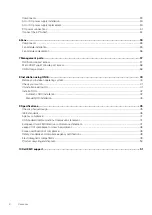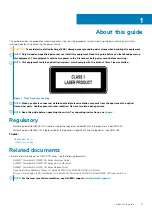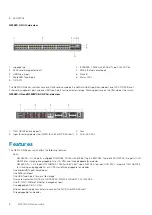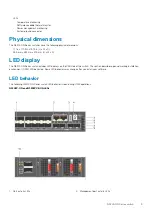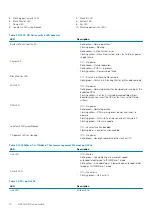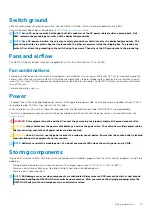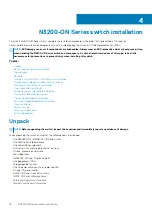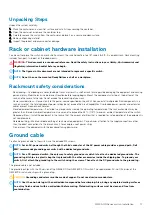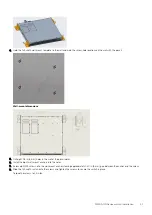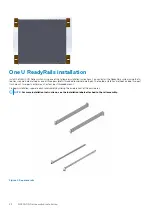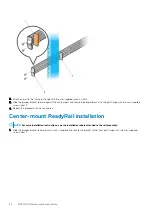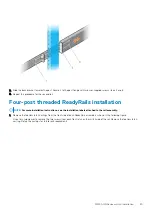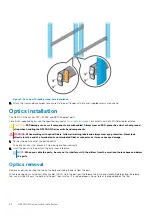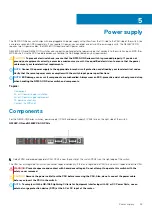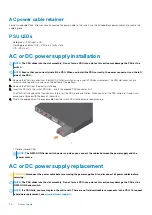
Unpacking Steps
Unpack the system carefully.
1. Place the container on a clean, flat surface and cut all straps securing the container.
2. Open the container, or remove the container top.
3. Carefully remove the switch from the container and place it on a secure and clean surface.
4. Remove all packing material.
5. Inspect the product and accessories for damage.
Rack or cabinet hardware installation
You may either place the switch on a rack shelf or mount the switch directly into a 19" wide, EIA-310- E-compliant rack. Rack mounting
includes four-post, two-post, or threaded mounts.
WARNING:
This document is a condensed reference. Read the safety instructions in your
Safety, Environmental, and
Regulatory
information booklet before you begin.
NOTE:
The figures in this document are not intended to represent a specific switch.
NOTE:
Do not the use the mounted ReadyRails as a shelf or a workplace.
Rackmount safety considerations
•
Rack loading—Overloading or uneven loading of racks may result in shelf or rack failure, possibly damaging the equipment and causing
personal injury. Stabilize racks in a permanent location before loading begins. Mount the components starting at the bottom of the
rack, and then work to the top. Do not exceed the load rating of your rack.
•
Power considerations—Connect only to the power source specified on the unit. When you install multiple electrical components in a
rack, ensure that the total component power ratings do not exceed the circuit capabilities. Overloaded power sources and extension
cables present fire and shock hazards.
•
Elevated ambient temperature—If installed in a closed rack assembly, the operating temperature of the rack environment may be
greater than the room ambient temperature. Use care not to exceed the 45°C (113°F) maximum ambient temperature of the switch.
•
Reduced airflow—Install the equipment in the rack so that the amount of airflow that is required for safe operation of the equipment is
not compromised.
•
Reliable earthing—Maintain reliable earthing of rack-mounted equipment. Pay particular attention to the supply connections other
than the direct connections to the branch circuit, for example, use of power strips.
•
Do not mount the equipment with the backpanel facing downward.
Ground cable
To attach a ground cable to the switch, use the included M4 screws.
NOTE:
For an AC-powered switch, although the third conductor of the AC power cable provides a ground path, Dell
EMC recommends grounding your switch with a dedicated ground wire.
NOTE:
For a DC-powered switch, the only way to safely ground your switch is to attach a dedicated ground wire. The
ground lug kit ships in a plastic bag that is placed with the other accessories inside the shipping box. To ground your
switch, first attach the ground lug to the switch using the screws. Then attach the DC ground wire to the ground lug.
The ground cable is not included.
The ground lug ships with the DC version of the N3248P-ON or N3248PXE-ON switch. The special-order AC-no-OS version of the
N3248PXE switch also ships with a ground lug.
CAUTION:
Grounding conductors
must
be made of copper. Do not use aluminum conductors.
NOTE:
Coat the one-hole lug with an antioxidant compound before crimping. Also, bring any unplated mating surfaces
to a shiny finish and coat with an antioxidant before mating. Plated mating surfaces must be clean and free from
contamination.
N3200-ON Series switch installation
17


